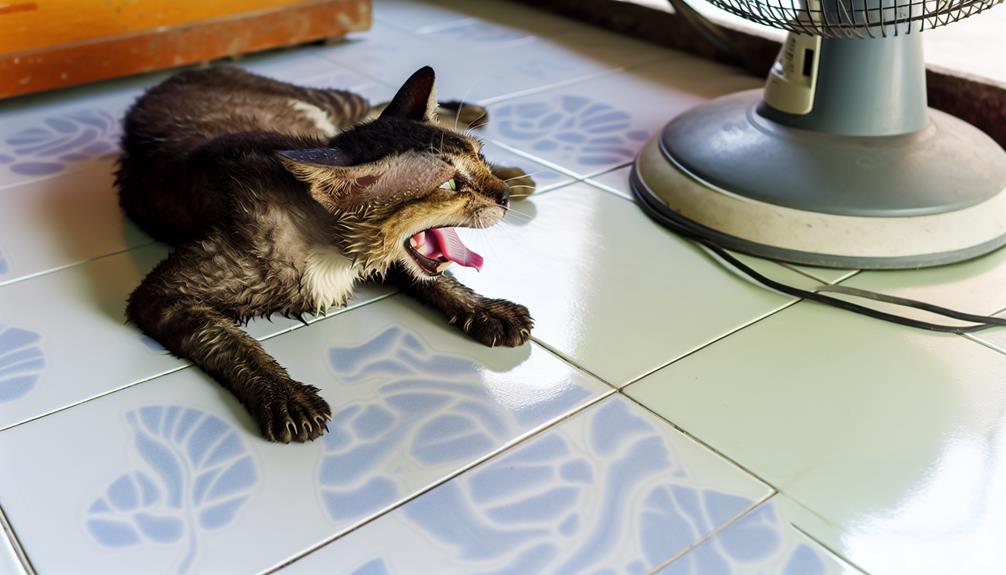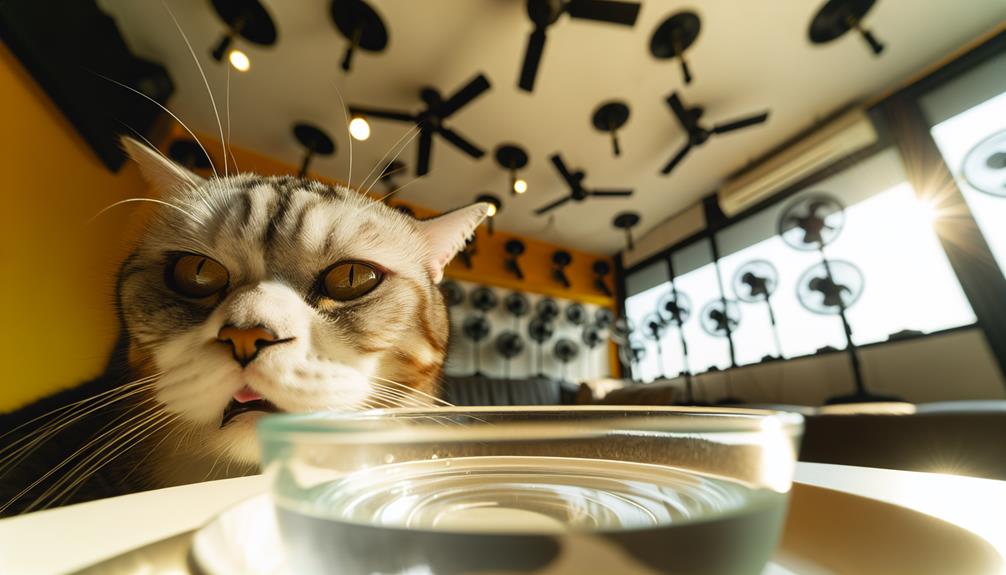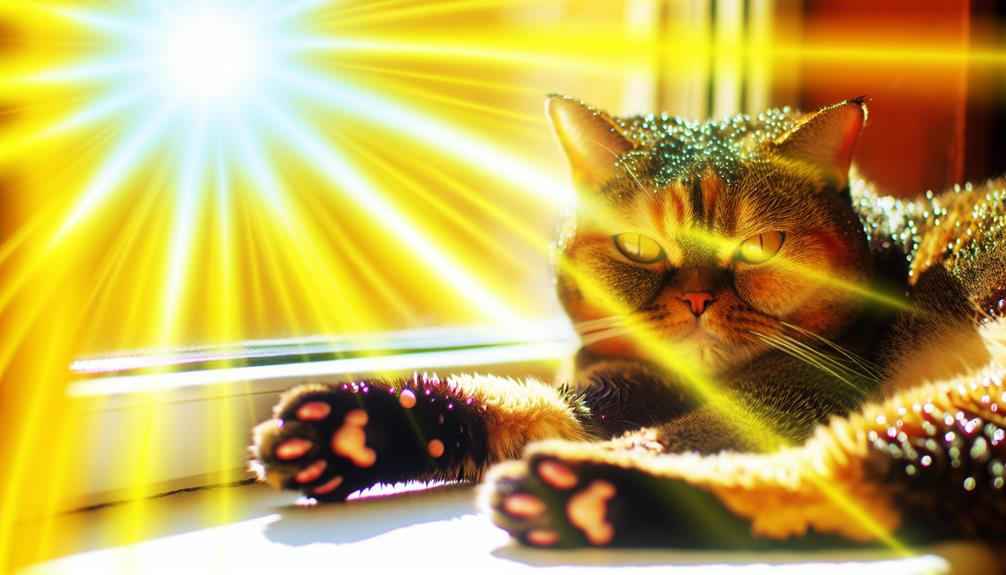You might think cats sweat like humans, but their bodies handle heat quite differently. Cats have sweat glands in their paw pads, yet these glands don't play a major role in cooling them down. Instead, they rely on a combination of grooming, finding cooler spots, and even panting when necessary. This limited sweating capacity makes them prone to overheating, especially in warmer climates. Curious about how else your feline friend manages to keep cool and what you can do to help? There's more to discover about their unique thermoregulation strategies and health implications.
Sweat Glands in Cats
Cats, like many mammals, possess sweat glands, but their distribution and function differ markedly from humans. You see, while humans have eccrine sweat glands distributed almost uniformly across their skin, cats have these glands primarily located in specific areas such as their paw pads. This unique sweat gland anatomy means that the primary function of feline sweat glands is not for regulating body temperature as it is in humans.
In cats, the eccrine sweat glands are largely confined to their paw pads. When a cat is stressed or anxious, you might notice wet paw prints as these glands become active. This phenomenon is more about emotional response rather than thermoregulation. The feline sweat function here is more aligned with providing grip and possibly leaving scent markers, rather than cooling the body.
Moreover, research indicates that in cats, the apocrine sweat glands, which are associated with hair follicles, play a minimal role in sweating. These glands are more involved in secreting pheromones rather than sweat. The limited distribution and specialized functions of these glands underscore the distinct evolutionary path felines have taken.
Clinically, it's important to recognize that since cats don't sweat extensively through their skin, they're prone to overheating if environmental conditions become extreme. Veterinary professionals need to be aware of this unique aspect of feline sweat gland anatomy and its implications for feline health. Understanding this can guide you in managing situations that might lead to heat stress in cats, ensuring their well-being and comfort.
Feline Cooling Mechanisms
Cats possess limited sweat glands located primarily in their paw pads, which play a minor role in thermoregulation. Instead, you'll observe that they rely heavily on grooming behaviors, where the evaporation of saliva from their fur aids in cooling. Additionally, cats exhibit various heat dissipation behaviors such as seeking shade and stretching out to maximize air flow across their bodies.
Sweat Glands in Cats
Unlike humans, feline cooling mechanisms rely on a limited number of sweat glands, mainly located in their paw pads. Cats possess two main types of sweat glands: eccrine and apocrine glands. The eccrine glands are chiefly found in the paw pads and are responsible for the minor sweat function in felines. Unlike the human body's widespread eccrine glands, a cat's eccrine glands don't contribute greatly to thermoregulation.
| Gland Type | Location | Function |
|---|---|---|
| Eccrine | Paw Pads | Minor sweat function |
| Apocrine | Throughout Skin | Scent marking |
| Sebaceous | Near Hair Follicles | Lubrication |
| Ceruminous | Ear Canal | Earwax production |
The apocrine glands, scattered throughout a cat's skin, are mainly involved in scent marking rather than cooling. These glands secrete a thicker fluid, which mixes with sebum produced by sebaceous glands. This secretion aids in marking territory and social interactions, rather than playing a considerable role in cooling.
Grooming and Saliva Cooling
Feline thermoregulation mainly relies on grooming behaviors and the cooling effect of saliva. When your cat grooms itself, it's not just maintaining hygiene; it's engaging in an essential process for temperature regulation. Cats lack significant sweat glands across their bodies, so they've adapted alternative mechanisms. By grooming, they spread saliva over their fur. This saliva then evaporates, facilitating heat dissipation through a process known as evaporative cooling.
Scientific studies have shown that a cat's grooming behaviors can cover 50% of its body surface. The saliva cooling mechanism is especially important during high ambient temperatures. Unlike humans, who rely heavily on eccrine sweat glands, cats depend on this method to avoid hyperthermia. The act of grooming increases blood flow to the skin, which also aids in heat transfer.
Clinically, you'll notice that during hot weather, cats might groom more frequently. This behavior is not merely indicative of stress but rather a sophisticated, innate response to thermal stress. Understanding these mechanisms offers insights into feline health, particularly in managing conditions related to thermoregulation. Remember, adequate hydration is essential to support your cat's saliva production and, consequently, its ability to cool down efficiently.
Heat Dissipation Behaviors
While grooming plays a significant role in feline thermoregulation, there are other heat dissipation behaviors your cat employs to maintain an ideal body temperature. One primary method is seeking cooler environments. Cats instinctively move to shaded or cooler areas, such as tiled floors or bathtubs, to aid in heat regulation. This behavior adaptation minimizes heat absorption from their surroundings.
Panting is another physiological response, albeit less common in cats compared to dogs. When your cat pants, it increases evaporative cooling by expelling warm, moist air and drawing in cooler, drier air. Although panting is a secondary mechanism, it becomes vital in extreme heat conditions.
Additionally, stretching out is a notable behavior adaptation. By lying flat on the ground with limbs extended, your cat maximizes surface area exposure, facilitating heat dissipation. This posture helps in transferring body heat to cooler surfaces.
Moreover, vasodilation, the widening of blood vessels, occurs to enhance peripheral blood flow, thereby promoting heat loss. This process is often accompanied by subtle behavioral cues, such as increased grooming around the ears and paws, where blood vessels are closer to the skin surface.
Understanding these heat regulation behaviors can help you guarantee your cat's comfort during warmer seasons.
Signs of Overheating

When your cat is overheating, you'll notice clinical signs such as panting and drooling, which indicate respiratory distress. An elevated heart rate is another critical marker, often accompanied by the cat seeking out cooler areas to regulate its body temperature. Immediate intervention is essential to prevent heat stroke and other serious complications.
Panting and Drooling
Although cats are known for their composure, panting and drooling can be alarming signs of overheating that you should never ignore. Panting behavior in felines is atypical and often indicates thermal stress. Unlike dogs, cats don't usually pant to regulate their body temperature. When a cat starts exhibiting panting behavior, it's a sign that their normal thermoregulatory mechanisms are overwhelmed.
The drooling causes in overheating scenarios are linked to hyperthermia-induced salivation. Excessive drooling, or hypersalivation, occurs when a cat's body struggles to dissipate excess heat. This physiological response is the body's attempt to cool down, similar to how humans might sweat profusely during extreme heat. However, in cats, it can quickly escalate to dangerous levels if not promptly addressed.
Scientific evidence suggests that a combination of panting and drooling in cats is a red flag for immediate intervention. Confirm the cat is moved to a cooler environment, provided with fresh water, and monitored closely. If symptoms persist, seek veterinary attention without delay. Overheating can lead to more severe conditions like heatstroke, making it vital to act swiftly when these signs are observed.
Elevated Heart Rate
An elevated heart rate is a crucial indicator of overheating in cats, signaling that their bodies are under considerable thermal stress. When a cat's core temperature rises, its physiology responds by increasing the heart rate to enhance blood flow and facilitate heat dissipation. This tachycardic response is part of the cat's stress response, aiming to protect essential organs from thermal damage.
Clinically, a cat's normal resting heart rate ranges between 140 and 220 beats per minute. During episodes of overheating, you'll observe rates markedly above this baseline. The elevated heart rate is a compensatory mechanism to promote peripheral vasodilation, allowing greater heat loss through the skin. However, this physiological response can only be sustained for so long before it leads to cardiovascular strain and potential organ failure.
Studies have shown that prolonged exposure to high temperatures can precipitate hyperthermia, severely impacting a cat's cardiovascular system. Monitoring your cat's heart rate can therefore provide invaluable insights into its thermal stress levels. Employing a stethoscope or palpating the femoral artery are effective methods to detect an elevated heart rate. Recognizing this sign early can be crucial in initiating timely interventions to mitigate the adverse effects of overheating on your cat's overall health.
Seeking Cool Areas
Cats instinctively seek cool areas when they're overheating, a behavior driven by their need to regulate body temperature. This thermoregulatory mechanism involves finding shaded spots and cool surfaces, which serve as effective means to dissipate excess heat. When you notice your cat gravitating towards tiled floors, bathtubs, or shaded areas under furniture, it's a clear indication they're attempting to cool down.
Several scientific studies have documented this behavior. Research shows that cats exhibit a preference for cool surfaces, such as ceramic tiles or concrete, which can effectively conduct heat away from their bodies. These surfaces provide an immediate cooling effect due to their thermal properties, aiding in the cat's thermoregulation.
Moreover, shaded spots offer an environment with reduced solar radiation, further mitigating the risk of overheating. You might observe your cat resting under trees, bushes, or beneath the shade of a building during warmer months. This behavior is vital for preventing hyperthermia, a potentially life-threatening condition.
Understanding these signs of overheating is important for any cat owner. By recognizing and facilitating access to cool areas, you can help your feline companion maintain an ideal body temperature and overall well-being.
Grooming and Temperature Control
Curiously, feline grooming serves an important role in temperature regulation. Cats engage in meticulous grooming habits not merely for cleanliness but also as a sophisticated means to manage their body temperature. When a cat licks its fur, saliva is deposited on the coat. As this saliva evaporates, it produces a cooling effect similar to the way perspiration functions in humans. This evaporative cooling mechanism is a vital aspect of a cat's thermoregulation strategy, especially since cats possess relatively few sweat glands, which are mainly located on their paw pads.
The licking behavior, or grooming, increases greatly in warmer conditions, indicating an adaptive response to thermal stress. Clinical observations reveal that cats may spend up to 50% of their waking hours grooming. This behavior is not merely habitual but a finely tuned physiological response to maintain homeostasis. Scientific evidence supports that the act of grooming distributes saliva across the fur, enhancing heat dissipation through evaporation. This grooming-induced thermoregulation is important given the limited efficacy of eccrine sweat glands on a cat's body.
Moreover, grooming also helps in removing excess fur, which can act as an insulator, thereby reducing the body's ability to release heat. By thinning out their coat, cats optimize their fur's insulating properties to suit environmental temperatures. Research has shown that cats in hotter climates tend to have shorter, less dense fur compared to those in cooler regions, indicating a natural selection for grooming behaviors that promote efficient temperature regulation.
Environmental Adjustments

To complement their grooming habits, felines employ various environmental adjustments to regulate their body temperature effectively. Cats exhibit notable climate adaptation behaviors, allowing them to thrive in diverse environmental conditions. One primary method is seeking out cool surfaces, such as tiled floors or shaded areas, during warmer months. This behavior is a direct response to their need to dissipate excess heat, showcasing their acute seasonal behavior adaptations.
In colder climates, cats will often gravitate towards heat sources. You might notice your cat curling up near radiators or basking in patches of sunlight streaming through windows. This behavior isn't merely for comfort; it's an essential aspect of thermoregulation. By positioning themselves in warmer areas, cats reduce the energy expenditure required to maintain their core body temperature, illustrating their sophisticated climate adaptation mechanisms.
Furthermore, cats are known to alter their activity levels based on seasonal changes. During hot weather, they typically exhibit reduced physical exertion, conserving energy and minimizing heat production. Conversely, in cooler conditions, they might engage in more vigorous play or hunting activities, which helps generate body heat. This seasonal behavior shift is a key element in their overall strategy to maintain thermal balance.
Additionally, the spatial arrangement of a cat's living environment can influence its temperature regulation strategies. Providing multiple resting areas with varying degrees of warmth and coolness allows your feline to choose the most suitable spot for maintaining its ideal body temperature. By offering diverse microenvironments, you support their inherent ability to adapt to fluctuating climates, ensuring their comfort and well-being. Through these environmental adjustments, cats demonstrate remarkable efficiency in managing thermal stress.
Health Considerations
When considering the health implications of thermoregulation in felines, it's important to understand the physiological mechanisms at play. Cats, unlike humans, lack an extensive network of sweat glands. They primarily have eccrine glands located in their paw pads, which play a minimal role in overall body temperature regulation. Consequently, felines rely heavily on behavioral adaptations, such as seeking shade and grooming, to manage their body temperature.
Hydration importance cannot be overstated when discussing feline thermoregulation. Water is essential for various physiological processes, including temperature control. Cats are known to have a low thirst drive, which can be problematic during hot weather or periods of increased physical activity. Make sure your cat has constant access to fresh water, especially in the summer months. You might also consider wet cat food, which has higher water content, to aid in hydration.
Seasonal adaptation is another significant factor in feline thermoregulation. During warmer months, cats will naturally shed their winter coats, reducing insulation and allowing for better heat dissipation. However, it's also important to monitor their environment. Overheating can lead to heatstroke, a severe condition characterized by symptoms like panting, drooling, and lethargy. Immediate veterinary intervention is necessary if these signs are observed.
In colder seasons, maintaining a warm environment is essential, as cats don't have the same capacity as dogs to generate heat through shivering. Providing warm bedding and making sure they're not exposed to drafts can help mitigate cold stress.
Conclusion
In principle, understanding your feline friend's unique cooling mechanisms is vital for their well-being. While cats don't sweat like we do, they've got their own clever ways of staying comfy. Keep an eye out for signs of overheating and make certain they've always got access to cool spots and fresh water. By doing so, you're not just a pet owner—you're a guardian of their health, guaranteeing they stay purrfectly content and cool.
